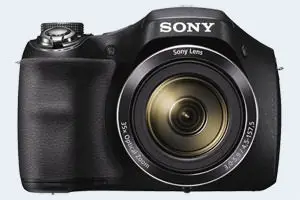Panasonic TS7 vs Sony H300
The Panasonic Lumix DC-TS7 (called Panasonic FT7 in some regions) and the Sony Cyber-shot DSC-H300 are two digital cameras that were officially introduced, respectively, in May 2018 and February 2014. Both the TS7 and the H300 are fixed lens compact cameras that are equipped with a 1/2.3-inch sensor. The Panasonic has a resolution of 20.2 megapixels, whereas the Sony provides 19.9 MP.
Below is an overview of the main specs of the two cameras as a starting point for the comparison.

Check TS7 offers at
ebay.com

Check H300 offers at
ebay.com
Going beyond this snapshot of core features and characteristics, what are the differences between the Panasonic Lumix DC-TS7 and the Sony Cyber-shot DSC-H300? Which one should you buy? Read on to find out how these two cameras compare with respect to their body size, their imaging sensors, their shooting features, their input-output connections, and their reception by expert reviewers.
Body comparison
The physical size and weight of the Panasonic TS7 and the Sony H300 are illustrated in the side-by-side display below. The two cameras are presented according to their relative size. Three successive views from the front, the top, and the rear are shown. All width, height and depth measures are rounded to the nearest millimeter.
The TS7 can be obtained in three different colors (black, blue, orange), while the H300 is only available in black.
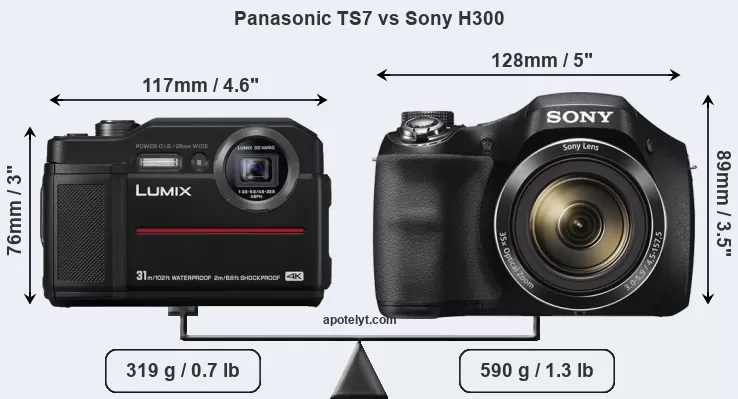
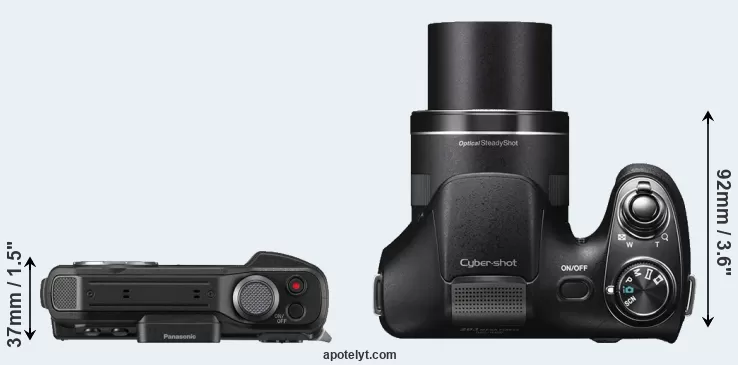
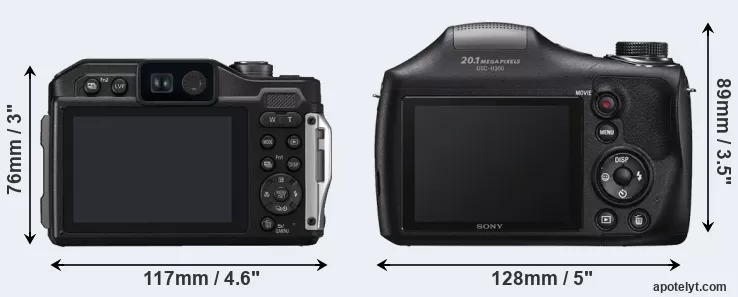
If the front view area (width x height) of the cameras is taken as an aggregate measure of their size, the Sony H300 is notably larger (28 percent) than the Panasonic TS7. Moreover, the H300 is substantially heavier (85 percent) than the TS7. It is worth mentioning in this context that the TS7 is splash and dust resistant, while the H300 does not feature any corresponding weather-sealing. More than that, the TS7 is water-proof up to 31m and can, thus, be used for underwater photography.
The power pack in the TS7 can be charged via the USB port, so that it is not always necessary to take the battery charger along when travelling.
The table below summarizes the key physical specs of the two cameras alongside a broader set of comparators. In case you want to display and compare another camera duo, you can use the CAM-parator app to select your camera combination among a large number of options.

| # | Camera Model |
Camera Width |
Camera Height |
Camera Depth |
Camera Weight |
Battery Life |
Weather Sealing |
Camera Launch |
Launch Price (USD) |
Street Price |
|
|---|---|---|---|---|---|---|---|---|---|---|---|
| 1. | Panasonic TS7 | 117 mm | 76 mm | 37 mm | 319 g | 300 | Y | May 2018 | 449 | ebay.com | |
| 2. | Sony H300 | 128 mm | 89 mm | 92 mm | 590 g | 350 | n | Feb 2014 | 219 | ebay.com | |
| 3. | Canon SX740 | 110 mm | 64 mm | 40 mm | 299 g | 265 | n | Jul 2018 | 399 | amazon.com | |
| 4. | Canon SX730 | 110 mm | 64 mm | 40 mm | 300 g | 250 | n | Apr 2017 | 399 | ebay.com | |
| 5. | Canon SX610 | 105 mm | 61 mm | 27 mm | 191 g | 270 | n | Jan 2015 | 249 | ebay.com | |
| 6. | Fujifilm XF10 | 113 mm | 64 mm | 41 mm | 279 g | 330 | n | Jul 2018 | 499 | ebay.com | |
| 7. | Nikon W300 | 112 mm | 66 mm | 29 mm | 231 g | 280 | Y | May 2017 | 389 | ebay.com | |
| 8. | Panasonic ZS80 | 112 mm | 69 mm | 42 mm | 327 g | 380 | n | Feb 2019 | 449 | ebay.com | |
| 9. | Panasonic ZS70 | 112 mm | 67 mm | 41 mm | 322 g | 380 | n | Apr 2017 | 449 | ebay.com | |
| 10. | Panasonic FZ80 | 130 mm | 94 mm | 119 mm | 616 g | 330 | n | Jan 2017 | 399 | ebay.com | |
| 11. | Ricoh WG-6 | 118 mm | 66 mm | 33 mm | 246 g | 340 | Y | Feb 2019 | 399 | amazon.com | |
| 12. | Sony HX99 | 102 mm | 58 mm | 36 mm | 242 g | 370 | n | Aug 2018 | 449 | ebay.com | |
| 13. | Sony HX95 | 102 mm | 58 mm | 36 mm | 242 g | 370 | n | Aug 2018 | 429 | ebay.com | |
| 14. | Sony HX90V | 102 mm | 58 mm | 36 mm | 245 g | 360 | n | Apr 2015 | 429 | ebay.com | |
| 15. | Sony HX400V | 130 mm | 93 mm | 103 mm | 660 g | 300 | n | Feb 2014 | 499 | ebay.com | |
| 16. | Sony H400 | 130 mm | 95 mm | 122 mm | 628 g | 300 | n | Feb 2014 | 319 | ebay.com | |
| 17. | Sony H200 | 123 mm | 83 mm | 87 mm | 530 g | 240 | n | Jan 2013 | 249 | ebay.com | |
| Note: Measurements and pricing do not include easily detachable parts, such as add-on or interchangeable lenses or optional viewfinders. | |||||||||||
Any camera decision will naturally be influenced heavily by the price. The manufacturer’s suggested retail prices give an idea on the placement of the camera in the maker’s lineup and the broader market. The H300 was launched at a markedly lower price (by 51 percent) than the TS7, which puts it into a different market segment. Usually, retail prices stay at first close to the launch price, but after several months, discounts become available. Later in the product cycle and, in particular, when the replacement model is about to appear, further discounting and stock clearance sales often push the camera price considerably down.
Sensor comparison
The size of the imaging sensor is a crucial determinant of image quality. A large sensor will tend to have larger individual pixels that provide better low-light sensitivity, wider dynamic range, and richer color-depth than smaller pixel-units in a sensor of the same technological generation. Furthermore, a large sensor camera will give the photographer more possibilities to use shallow depth-of-field in order to isolate a subject from the background. On the downside, larger sensors tend to be more expensive and lead to bigger and heavier cameras and lenses.
Both cameras under consideration feature a 1/2.3-inch sensor and have a format factor (sometimes also referred to as "crop factor") of 5.6. Within the spectrum of camera sensors, this places the review cameras among the smaller-sensor digicams that favor affordability and compact design. Both cameras feature a native aspect ratio (sensor width to sensor height) of 4:3.
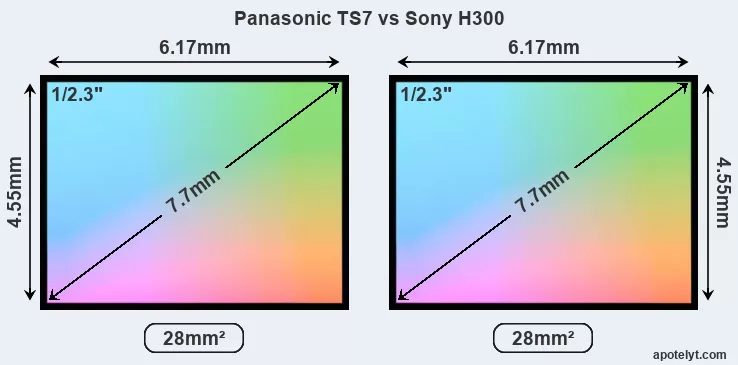
While the two cameras under review share the same sensor size, the TS7 offers a slightly higher resolution of 20.2 megapixels, compared with 19.9 MP of the H300. This megapixels advantage translates into a 0.59999999999999 percent gain in linear resolution. On the other hand, these sensor specs imply that the TS7 has a higher pixel density and a smaller size of the individual pixel (with a pixel pitch of 1.18μm versus 1.19μm for the H300). In this context, it should be noted, however, that the TS7 is much more recent (by 4 years and 2 months) than the H300, and its sensor will have benefitted from technological advances during this time that compensate for the smaller pixel size. Coming back to sensor resolution, it should be mentioned that the H300 has no anti-alias filter installed, so that it can capture all the detail its sensor resolves.
The Panasonic Lumix DC-TS7 has a native sensitivity range from ISO 80 to ISO 3200, which can be extended to ISO 80-6400. The corresponding ISO settings for the Sony Cyber-shot DSC-H300 are ISO 80 to ISO 3200 (no boost).
In terms of underlying technology, the TS7 is build around a BSI-CMOS sensor, while the H300 uses a CCD imager. Both cameras use a Bayer filter for capturing RGB colors on a square grid of photosensors. This arrangement is found in most digital cameras.
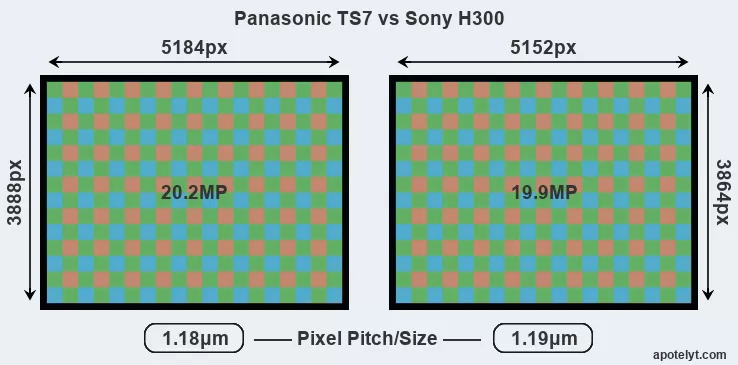
For many cameras, data on sensor performance has been reported by DXO Mark. This service determines an overall sensor rating, as well as sub-scores for low-light sensitivity ("DXO Sports"), dynamic range ("DXO Landscape"), and color depth ("DXO Portrait"). The table below summarizes the physical sensor characteristics and sensor quality findings and compares them across a set of similar cameras.

| # | Camera Model |
Sensor Class |
Resolution (MP) |
Horiz. Pixels |
Vert. Pixels |
Video Format |
DXO Portrait |
DXO Landscape |
DXO Sports |
DXO Overall |
|
|---|---|---|---|---|---|---|---|---|---|---|---|
| 1. | Panasonic TS7 | 1/2.3 | 20.2 | 5184 | 3888 | 4K/30p | 20.6 | 12.1 | 1028 | 51 | |
| 2. | Sony H300 | 1/2.3 | 19.9 | 5152 | 3864 | 720/30p | 20.1 | 11.4 | 630 | 45 | |
| 3. | Canon SX740 | 1/2.3 | 20.2 | 5184 | 3888 | 4K/30p | 20.6 | 12.1 | 1050 | 51 | |
| 4. | Canon SX730 | 1/2.3 | 20.2 | 5184 | 3888 | 1080/60p | 20.5 | 11.9 | 924 | 50 | |
| 5. | Canon SX610 | 1/2.3 | 20.2 | 5184 | 3888 | 1080/30p | 20.2 | 11.6 | 712 | 47 | |
| 6. | Fujifilm XF10 | APS-C | 24.0 | 6000 | 4000 | 4K/15p | 24.0 | 13.4 | 1844 | 83 | |
| 7. | Nikon W300 | 1/2.3 | 15.9 | 4608 | 3456 | 4K/30p | 20.5 | 12.0 | 938 | 50 | |
| 8. | Panasonic ZS80 | 1/2.3 | 20.2 | 5184 | 3888 | 4K/30p | 20.7 | 12.2 | 1103 | 52 | |
| 9. | Panasonic ZS70 | 1/2.3 | 20.2 | 5184 | 3888 | 4K/30p | 19.1 | 10.6 | 106 | 36 | |
| 10. | Panasonic FZ80 | 1/2.3 | 18.0 | 4896 | 3672 | 4K/30p | 20.5 | 11.9 | 900 | 49 | |
| 11. | Ricoh WG-6 | 1/2.3 | 20.2 | 5184 | 3888 | 4K/30p | 20.7 | 12.2 | 1104 | 52 | |
| 12. | Sony HX99 | 1/2.3 | 18.0 | 4896 | 3672 | 4K/30p | 20.6 | 12.1 | 1058 | 51 | |
| 13. | Sony HX95 | 1/2.3 | 18.0 | 4896 | 3672 | 4K/30p | 20.6 | 12.1 | 1057 | 51 | |
| 14. | Sony HX90V | 1/2.3 | 18.0 | 4896 | 3672 | 1080/60p | 20.2 | 11.6 | 738 | 47 | |
| 15. | Sony HX400V | 1/2.3 | 20.2 | 5184 | 3888 | 1080/60p | 20.1 | 11.4 | 629 | 45 | |
| 16. | Sony H400 | 1/2.3 | 19.9 | 5152 | 3864 | 720/30p | 20.1 | 11.4 | 630 | 45 | |
| 17. | Sony H200 | 1/2.3 | 15.2 | 5184 | 2930 | 720/30p | 19.9 | 11.2 | 529 | 44 | |
| Note: DXO values in italics represent estimates based on sensor size and age. | |||||||||||
Many modern cameras are not only capable of taking still images, but can also record movies. Both cameras under consideration are equipped with sensors that have a sufficiently high read-out speed for moving images, but the TS7 provides a higher video resolution than the H300. It can shoot video footage at 4K/30p, while the Sony is limited to 720/30p.
Feature comparison
Beyond body and sensor, cameras can and do differ across a range of features. For example, the TS7 has an electronic viewfinder (1170k dots), which can be very helpful when shooting in bright sunlight. In contrast, the H300 relies on live view and the rear LCD for framing. The table below summarizes some of the other core capabilities of the Panasonic TS7 and Sony H300 in connection with corresponding information for a sample of similar cameras.

| # | Camera Model |
Viewfinder (Type or 000 dots) |
Control Panel (yes/no) |
LCD Specifications (inch/000 dots) |
LCD Attach- ment |
Touch Screen (yes/no) |
Max Shutter Speed * |
Max Shutter Flaps * |
Built-in Flash (yes/no) |
Built-in Image Stab |
|
|---|---|---|---|---|---|---|---|---|---|---|---|
| 1. | Panasonic TS7 | 1170 | n | 3.0 / 1040 | fixed | n | 1/1300s | 10.0/s | Y | Y | |
| 2. | Sony H300 | none | n | 3.0 / 460 | fixed | n | 1/1500s | 0.8/s | Y | Y | |
| 3. | Canon SX740 | none | n | 3.0 / 922 | tilting | n | 1/3200s | 10.0/s | Y | Y | |
| 4. | Canon SX730 | none | n | 3.0 / 922 | tilting | n | 1/3200s | 5.9/s | Y | Y | |
| 5. | Canon SX610 | none | n | 3.0 / 922 | fixed | n | 1/2000s | 2.5/s | Y | Y | |
| 6. | Fujifilm XF10 | none | n | 3.0 / 1040 | fixed | Y | 1/4000s | 6.0/s | Y | n | |
| 7. | Nikon W300 | none | n | 3.0 / 921 | fixed | n | 1/4000s | 7.0/s | Y | Y | |
| 8. | Panasonic ZS80 | 2330 | n | 3.0 / 1040 | tilting | Y | 1/2000s | 10.0/s | Y | Y | |
| 9. | Panasonic ZS70 | 1166 | n | 3.0 / 1040 | tilting | Y | 1/2000s | 10.0/s | Y | Y | |
| 10. | Panasonic FZ80 | 1166 | n | 3.0 / 1040 | fixed | Y | 1/2000s | 10.0/s | Y | Y | |
| 11. | Ricoh WG-6 | none | n | 3.0 / 1040 | fixed | n | 1/4000s | 1.0/s | Y | n | |
| 12. | Sony HX99 | 638 | n | 3.0 / 922 | tilting | Y | 1/2000s | 10.0/s | Y | Y | |
| 13. | Sony HX95 | 638 | n | 3.0 / 922 | tilting | n | 1/2000s | 10.0/s | Y | Y | |
| 14. | Sony HX90V | 638 | n | 3.0 / 921 | tilting | n | 1/2000s | 10.0/s | Y | Y | |
| 15. | Sony HX400V | 210 | n | 3.0 / 921 | tilting | n | 1/4000s | 10.0/s | Y | Y | |
| 16. | Sony H400 | 210 | n | 3.0 / 460 | fixed | n | 1/2000s | 0.7/s | Y | Y | |
| 17. | Sony H200 | none | n | 3.0 / 460 | fixed | n | 1/1500s | 0.8/s | Y | Y | |
| Note: *) Information refers to the mechanical shutter, unless the camera only has an electronic one. | |||||||||||
The reported shutter speed information refers to the use of the mechanical shutter. Yet, some cameras only have an electronic shutter, while others have an electronic shutter in addition to a mechanical one. In fact, the TS7 is one of those camera that have an additional electronic shutter, which makes completely silent shooting possible. However, this mode is less suitable for photographing moving objects (risk of rolling shutter) or shooting under artificial light sources (risk of flickering).
Both the TS7 and the H300 have zoom lenses built in. The TS7 has a 28-128mm f/3.3-5.9 optic and the H300 offers a 25-875mm f/3.4-6.5 (focal lengths in full frame equivalent terms). Hence, the Sony provides a wider angle of view at the short end, as well as more tele-photo reach at the long end than the Panasonic. The TS7 offers the faster maximum aperture.
The TS7 writes its imaging data to SDXC cards, while the H300 uses SDXC or Memory Stick PRO Duo cards. The TS7 supports UHS-I cards (Ultra High Speed data transfer of up to 104 MB/s), while the H300 cannot take advantage of Ultra High Speed SD cards.
Connectivity comparison
For some imaging applications, the extent to which a camera can communicate with its environment can be an important aspect in the camera decision process. The table below provides an overview of the connectivity of the Panasonic Lumix DC-TS7 and Sony Cyber-shot DSC-H300 and, in particular, the interfaces the cameras (and selected comparators) provide for accessory control and data transfer.

| # | Camera Model |
Hotshoe Port |
Internal Mic / Speaker |
Microphone Port |
Headphone Port |
HDMI Port |
USB Port |
WiFi Support |
NFC Support |
Bluetooth Support |
|
|---|---|---|---|---|---|---|---|---|---|---|---|
| 1. | Panasonic TS7 | - | stereo / mono | - | - | micro | 2.0 | Y | - | - | |
| 2. | Sony H300 | - | mono / mono | - | - | micro | 2.0 | Y | - | - | |
| 3. | Canon SX740 | - | stereo / mono | - | - | micro | 2.0 | Y | - | Y | |
| 4. | Canon SX730 | - | stereo / mono | - | - | micro | 2.0 | Y | Y | Y | |
| 5. | Canon SX610 | - | - / - | - | - | micro | 2.0 | Y | Y | - | |
| 6. | Fujifilm XF10 | - | stereo / mono | Y | - | micro | 2.0 | Y | - | Y | |
| 7. | Nikon W300 | - | stereo / mono | - | - | micro | 2.0 | Y | - | Y | |
| 8. | Panasonic ZS80 | - | stereo / mono | - | - | micro | 2.0 | Y | - | Y | |
| 9. | Panasonic ZS70 | - | stereo / mono | - | - | micro | 2.0 | Y | - | - | |
| 10. | Panasonic FZ80 | Y | stereo / mono | - | - | micro | 2.0 | Y | - | - | |
| 11. | Ricoh WG-6 | - | mono / mono | - | - | micro | 3.0 | - | - | - | |
| 12. | Sony HX99 | - | stereo / mono | - | - | micro | 2.0 | Y | Y | Y | |
| 13. | Sony HX95 | - | stereo / mono | - | - | micro | 2.0 | Y | Y | Y | |
| 14. | Sony HX90V | - | stereo / mono | - | - | micro | 2.0 | Y | Y | - | |
| 15. | Sony HX400V | Y | stereo / mono | - | - | micro | 2.0 | Y | Y | - | |
| 16. | Sony H400 | - | mono / mono | - | - | micro | 2.0 | Y | - | - | |
| 17. | Sony H200 | - | mono / mono | - | - | - | 2.0 | - | - | - |
Both the TS7 and the H300 have been discontinued, but can regularly be found used on ebay. Neither of the two has a direct successor, so they represent the end of the respective camera lines from Panasonic and Sony. Further information on the features and operation of the TS7 and H300 can be found, respectively, in the Panasonic TS7 Manual (free pdf) or the online Sony H300 Manual.
Review summary
So what is the bottom line? Which of the two cameras – the Panasonic TS7 or the Sony H300 – has the upper hand? Is one clearly better than the other? The listing below highlights the relative strengths of the two models.

Reasons to prefer the Panasonic Lumix DC-TS7:
- Better moiré control: Has an anti-alias filter to avoid artificial patterns to appear in images.
- Better video: Provides higher definition movie capture (4K/30p vs 720/30p).
- Easier framing: Has an electronic viewfinder for image composition and settings control.
- More detailed LCD: Has a higher resolution rear screen (1040k vs 460k dots).
- Faster burst: Shoots at higher frequency (10 vs 0.8 flaps/sec) to capture the decisive moment.
- Less disturbing: Has an electronic shutter option for completely silent shooting.
- Better light gathering: Has a lens with a wider maximum aperture (f/3.3 vs f/3.4).
- More compact: Is smaller (117x76mm vs 128x89mm) and thus needs less room in the bag.
- Less heavy: Is lighter (by 271g or 46 percent) and hence easier to carry around.
- Easier travel charging: Can be conveniently charged via its USB port.
- Better sealing: Is weather sealed to enable shooting in dusty or wet environments.
- Water-proof: Is rugged and sealed and can thus be used for underwater photography (up to 31m).
- Faster buffer clearing: Has an SD card interface that supports the UHS-I standard.
- More modern: Reflects 4 years and 2 months of technical progress since the H300 launch.

Advantages of the Sony Cyber-shot DSC-H300:
- Maximized detail: Lacks an anti-alias filter to exploit the sensor's full resolution potential.
- Faster shutter: Has higher mechanical shutter speed (1/1500s vs 1/1300s) to freeze action.
- Wider view: Has a wider-angle lens that facilitates landscape or interior shots.
- More tele-reach: Has a longer tele-lens for perspective compression and subject magnification.
- Longer lasting: Gets more shots (350 versus 300) out of a single battery charge.
- More affordable: Was introduced into a lower priced category (51 percent cheaper at launch).
- More heavily discounted: Has been around for much longer (launched in February 2014).
If the number of relative strengths (bullet points above) is taken as a guide, the TS7 is the clear winner of the match-up (14 : 7 points). However, the relevance of individual strengths will vary across photographers, so that you might want to apply your own weighing scheme to the summary points when reflecting and deciding on a new camera. A professional wildlife photographer will view the differences between cameras in a way that diverges from the perspective of a family photog, and a person interested in architecture has distinct needs from a sports shooter. Hence, the decision which camera is best and worth buying is often a very personal one.
How about other alternatives? Do the specifications of the Panasonic TS7 and the Sony H300 place the cameras among the top in their class? Find out in the latest Best Travel-Zoom Camera and Best Superzoom Camera listings whether the two cameras rank among the cream of the crop.
In any case, while the specs-based evaluation of cameras can be instructive in revealing their potential as photographic tools, it remains incomplete and does no justice, for example, to the way the TS7 or the H300 perform in practice. User reviews, such as those found at amazon, can sometimes inform about these issues, but such feedback is often incomplete, inconsistent, and biased.
Expert reviews
This is why expert reviews are important. The following table reports the overall ratings of the cameras as published by some of the major camera review sites (amateurphotographer [AP], cameralabs [CL], digitalcameraworld [DCW], dpreview [DPR], ephotozine [EPZ], photographyblog [PB]). As can be seen, the professional reviewers agree in many cases on the quality of different cameras, but sometimes their assessments diverge, reinforcing the earlier point that a camera decision is often a very personal choice.

| # | Camera Model |
AP score |
CL score |
DCW score |
DPR score |
EPZ score |
PB score |
Camera Launch |
Launch Price (USD) |
Street Price |
|
|---|---|---|---|---|---|---|---|---|---|---|---|
| 1. | Panasonic TS7 | .. | + | .. | .. | .. | 3.5/5 | May 2018 | 449 | ebay.com | |
| 2. | Sony H300 | .. | + | .. | .. | 4.5/5 | 4/5 | Feb 2014 | 219 | ebay.com | |
| 3. | Canon SX740 | .. | + | 3.5/5 | .. | 4/5 | 4/5 | Jul 2018 | 399 | amazon.com | |
| 4. | Canon SX730 | .. | + | .. | .. | 4/5 | 4/5 | Apr 2017 | 399 | ebay.com | |
| 5. | Canon SX610 | .. | .. | .. | .. | 4/5 | 4/5 | Jan 2015 | 249 | ebay.com | |
| 6. | Fujifilm XF10 | .. | .. | 4/5 | 75/100 | 4/5 | 4.5/5 | Jul 2018 | 499 | ebay.com | |
| 7. | Nikon W300 | .. | + | .. | .. | 4/5 | 4/5 | May 2017 | 389 | ebay.com | |
| 8. | Panasonic ZS80 | .. | + + | .. | .. | 4.5/5 | .. | Feb 2019 | 449 | ebay.com | |
| 9. | Panasonic ZS70 | .. | + + | .. | .. | 4/5 | 4/5 | Apr 2017 | 449 | ebay.com | |
| 10. | Panasonic FZ80 | .. | + + | .. | .. | 4.5/5 | 4.5/5 | Jan 2017 | 399 | ebay.com | |
| 11. | Ricoh WG-6 | .. | .. | .. | .. | 3.5/5 | 3.5/5 | Feb 2019 | 399 | amazon.com | |
| 12. | Sony HX99 | .. | .. | .. | .. | 4/5 | 4.5/5 | Aug 2018 | 449 | ebay.com | |
| 13. | Sony HX95 | .. | .. | .. | .. | .. | .. | Aug 2018 | 429 | ebay.com | |
| 14. | Sony HX90V | 4/5 | + + | .. | .. | 4/5 | 4.5/5 | Apr 2015 | 429 | ebay.com | |
| 15. | Sony HX400V | 4/5 | + + | .. | .. | 4/5 | 4/5 | Feb 2014 | 499 | ebay.com | |
| 16. | Sony H400 | .. | o | .. | .. | 3.5/5 | 3.5/5 | Feb 2014 | 319 | ebay.com | |
| 17. | Sony H200 | .. | .. | .. | .. | 3.5/5 | 3.5/5 | Jan 2013 | 249 | ebay.com | |
| Note: (+ +) highly recommended; (+) recommended; (o) reviewed; (..) not available. | |||||||||||
Care should be taken when interpreting the review scores above, though. The ratings are only valid when referring to cameras in the same category and of the same age. Hence, a score should always be seen in the context of the camera's market launch date and its price, and rating-comparisons among cameras that span long time periods or concern very differently equipped models make little sense. It should also be noted that some of the review sites have over time altered the way they render their verdicts.

Check TS7 offers at
ebay.com

Check H300 offers at
ebay.com
Other camera comparisons
Did this review help to inform your camera decision process? In case you would like to check on the differences and similarities of other camera models, just make your choice using the following search menu. There is also a set of direct links to comparison reviews that other users of the CAM-parator app explored.
- Canon 5D vs Panasonic TS7
- Canon 5D vs Sony H300
- Canon XS vs Sony H300
- Leica CL vs Panasonic TS7
- Nikon D700 vs Sony H300
- Nikon D80 vs Sony H300
- Olympus E-620 vs Panasonic TS7
- Panasonic GH6 vs Panasonic TS7
- Panasonic LX7 vs Panasonic TS7
- Panasonic TS7 vs Sony RX1R II
- Ricoh WG-6 vs Sony H300
- Sony A850 vs Sony H300
Specifications: Panasonic TS7 vs Sony H300
Below is a side-by-side comparison of the specs of the two cameras to facilitate a quick review of their differences and common features.
| Camera Model | Panasonic TS7 | Sony H300 |
|---|---|---|
| Camera Type | Fixed lens compact camera | Fixed lens compact camera |
| Camera Lens | 28-128mm f/3.3-5.9 | 25-875mm f/3.4-6.5 |
| Launch Date | May 2018 | February 2014 |
| Launch Price | USD 449 | USD 219 |
| Sensor Specs | Panasonic TS7 | Sony H300 |
| Sensor Technology | BSI-CMOS | CCD |
| Sensor Format | 1/2.3" Sensor | 1/2.3" Sensor |
| Sensor Size | 6.17 x 4.55 mm | 6.17 x 4.55 mm |
| Sensor Area | 28.0735 mm2 | 28.0735 mm2 |
| Sensor Diagonal | 7.7 mm | 7.7 mm |
| Crop Factor | 5.6x | 5.6x |
| Sensor Resolution | 20.2 Megapixels | 19.9 Megapixels |
| Image Resolution | 5184 x 3888 pixels | 5152 x 3864 pixels |
| Pixel Pitch | 1.18 μm | 1.19 μm |
| Pixel Density | 71.80 MP/cm2 | 70.91 MP/cm2 |
| Moiré control | Anti-Alias filter | no AA filter |
| Movie Capability | 4K/30p Video | 720/30p Video |
| ISO Setting | 80 - 3,200 ISO | 80 - 3,200 ISO |
| ISO Boost | 80 - 6,400 ISO | no Enhancement |
| Image Processor | Venus | BIONZ |
| Screen Specs | Panasonic TS7 | Sony H300 |
| Viewfinder Type | Electronic viewfinder | no viewfinder |
| Viewfinder Field of View | 100% | |
| Viewfinder Magnification | 0.45x | |
| Viewfinder Resolution | 1170k dots | |
| LCD Framing | Live View | Live View |
| Rear LCD Size | 3.0inch | 3.0inch |
| LCD Resolution | 1040k dots | 460k dots |
| LCD Attachment | Fixed screen | Fixed screen |
| Shooting Specs | Panasonic TS7 | Sony H300 |
| Focus System | Contrast-detect AF | Contrast-detect AF |
| Continuous Shooting | 10 shutter flaps/s | 0.8 shutter flaps/s |
| Electronic Shutter | up to 1/16000s | no E-Shutter |
| Fill Flash | Built-in Flash | Built-in Flash |
| Storage Medium | SDXC cards | MS or SDXC cards |
| Single or Dual Card Slots | Single card slot | Single card slot |
| UHS card support | UHS-I | no |
| Connectivity Specs | Panasonic TS7 | Sony H300 |
| External Flash | no Hotshoe | no Hotshoe |
| USB Connector | USB 2.0 | USB 2.0 |
| HDMI Port | micro HDMI | micro HDMI |
| Wifi Support | Wifi built-in | Wifi built-in |
| Body Specs | Panasonic TS7 | Sony H300 |
| Environmental Sealing | Waterproof body (31m) | not weather sealed |
| Battery Type | Panasonic DMW-BCM13 | Sony 4xAA |
| Battery Life (CIPA) | 300 shots per charge | 350 shots per charge |
| In-Camera Charging | USB charging | no USB charging |
| Body Dimensions |
117 x 76 x 37 mm (4.6 x 3.0 x 1.5 in) |
128 x 89 x 92 mm (5.0 x 3.5 x 3.6 in) |
| Camera Weight | 319 g (11.3 oz) | 590 g (20.8 oz) |

Check TS7 offers at
ebay.com

Check H300 offers at
ebay.com
Did you notice an error on this page? If so, please get in touch, so that we can correct the information.

